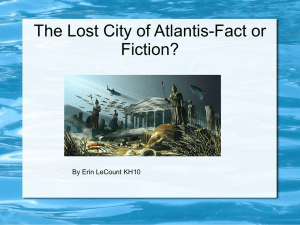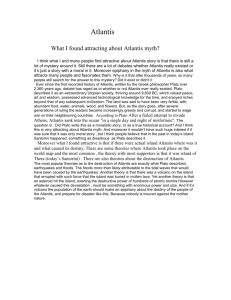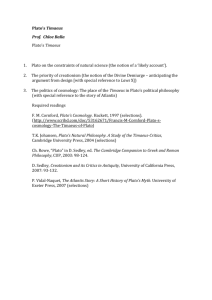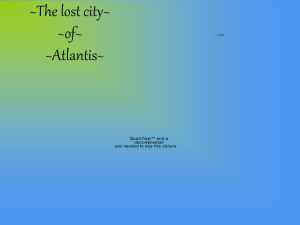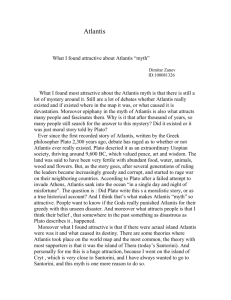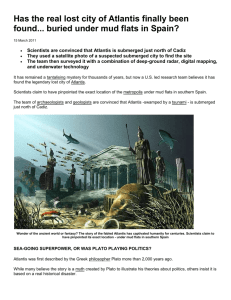Echoes of Plato`s Atlantis
advertisement
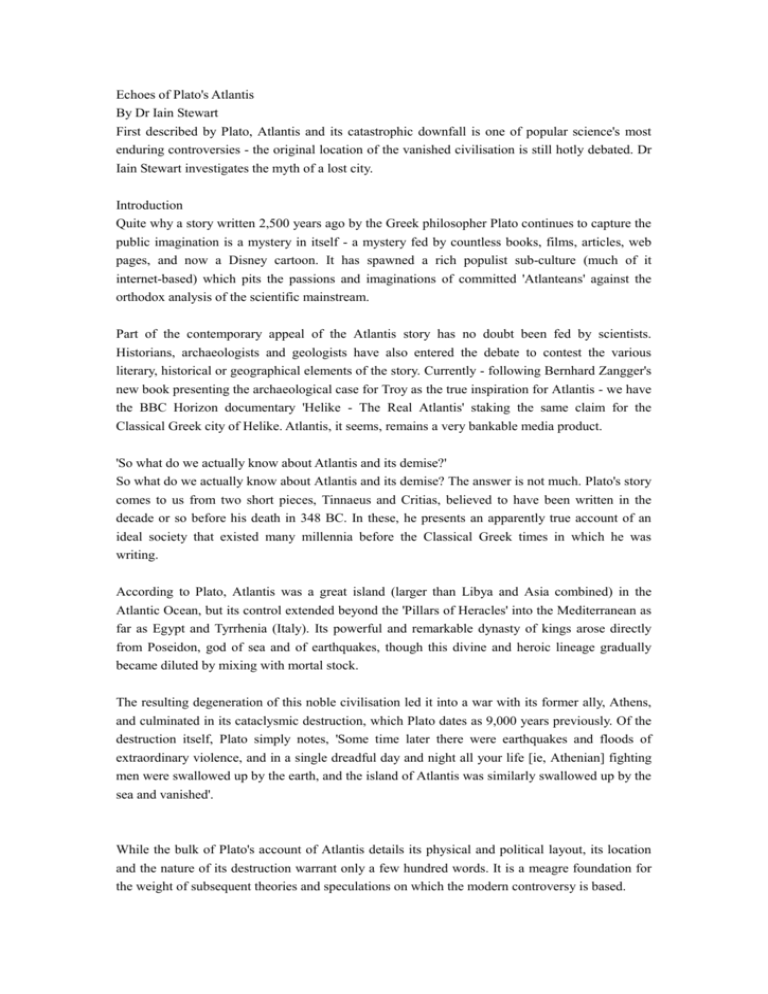
Echoes of Plato's Atlantis
By Dr Iain Stewart
First described by Plato, Atlantis and its catastrophic downfall is one of popular science's most
enduring controversies - the original location of the vanished civilisation is still hotly debated. Dr
Iain Stewart investigates the myth of a lost city.
Introduction
Quite why a story written 2,500 years ago by the Greek philosopher Plato continues to capture the
public imagination is a mystery in itself - a mystery fed by countless books, films, articles, web
pages, and now a Disney cartoon. It has spawned a rich populist sub-culture (much of it
internet-based) which pits the passions and imaginations of committed 'Atlanteans' against the
orthodox analysis of the scientific mainstream.
Part of the contemporary appeal of the Atlantis story has no doubt been fed by scientists.
Historians, archaeologists and geologists have also entered the debate to contest the various
literary, historical or geographical elements of the story. Currently - following Bernhard Zangger's
new book presenting the archaeological case for Troy as the true inspiration for Atlantis - we have
the BBC Horizon documentary 'Helike - The Real Atlantis' staking the same claim for the
Classical Greek city of Helike. Atlantis, it seems, remains a very bankable media product.
'So what do we actually know about Atlantis and its demise?'
So what do we actually know about Atlantis and its demise? The answer is not much. Plato's story
comes to us from two short pieces, Tinnaeus and Critias, believed to have been written in the
decade or so before his death in 348 BC. In these, he presents an apparently true account of an
ideal society that existed many millennia before the Classical Greek times in which he was
writing.
According to Plato, Atlantis was a great island (larger than Libya and Asia combined) in the
Atlantic Ocean, but its control extended beyond the 'Pillars of Heracles' into the Mediterranean as
far as Egypt and Tyrrhenia (Italy). Its powerful and remarkable dynasty of kings arose directly
from Poseidon, god of sea and of earthquakes, though this divine and heroic lineage gradually
became diluted by mixing with mortal stock.
The resulting degeneration of this noble civilisation led it into a war with its former ally, Athens,
and culminated in its cataclysmic destruction, which Plato dates as 9,000 years previously. Of the
destruction itself, Plato simply notes, 'Some time later there were earthquakes and floods of
extraordinary violence, and in a single dreadful day and night all your life [ie, Athenian] fighting
men were swallowed up by the earth, and the island of Atlantis was similarly swallowed up by the
sea and vanished'.
While the bulk of Plato's account of Atlantis details its physical and political layout, its location
and the nature of its destruction warrant only a few hundred words. It is a meagre foundation for
the weight of subsequent theories and speculations on which the modern controversy is based.
Lost cities
Today, the myriad of theories - many of them breathtakingly fantastic ('Atlantis was an exploded
planet'!) - ensures that the true nature of Plato's story is as elusive as ever. For those committed
Atlanteans that believe Atlantis existed much as Plato described, the possible locations of the lost
city are becoming increasingly exotic. Recent candidates lie as far afield as the Caribbean, South
America, Antarctica, Ireland and French Polynesia.
Many theories, however, contend that the Plato's Atlantis refers to the rise and fall of a known
ancient civilisation, though one whose age or location differs from that expressed by Plato. Which
ancient civilisation, of course, is a matter of vigorous debate. The Minoans of Crete have long
been a popular choice, though there are plenty of other suggestions, one of which, Troy, has been
given fresh support by Zangger.
However, the fact that each of these competing theories requires some degree of adjustment (or
re-interpretation of Plato's original account) has led many scholars to adopt the view held by many
of his contemporaries - that Atlantis is a piece of fiction and is arguably best summed up in the
words of the American classical scholar Daniel Dombrowski:
'Atlantis was only a powerful literary device invented by Plato, which was to act as a means of
highlighting the fate of the ideal state created in Plato's mind's eye. The only place in which
Atlantis can be found, in addition to the writings of Plato, is in the minds of those with an
imagination as vivid as that of Plato.'
'Atlantis was only a powerful literary device invented by Plato...'
But if it was fictional, to what extent is the story drawn from or coloured by events in Classical
Greek history? The story was written during a remarkable golden age of observation and discourse
about the natural world. Through the writings of contemporary scholars like Herodotus,
Thucydides, Aristotle and Callisthenes, historical seismologists have been able to piece together a
picture of earthquakes affecting Greece at this time. That picture reveals that earthquakes struck
with a frequency and ferociousness which far exceeds anything modern records have documented
in recent centuries. Perhaps more significantly, several of these earthquakes assumed great
political and cultural importance.
Earthquake war
The first earthquake of 'epoch-making importance' struck Sparta in 469-464 BC, occurring at a
time when the balance of power between Sparta and Athens was in a delicate state. It took Sparta
by surprise, killing more than 20,000 Spartans and immediately leading to internal and external
uprisings by its subject peoples. The result was the so-called 'earthquake war' between the
Spartans and their neighbours, during which Sparta's refusal to accept help from Athens resulted in
increased hostilities between them. These hostilities festered for decades, culminating in 431 BC
with the start of the Peloponnesian Wars, a 25-year bloody civil war between Sparta and her allies
and Athens and her allies.
'...the summer of 426 BC brought one of the most disastrous earthquakes recorded in the ancient
sources.'
Shortly after the start of the Peloponnesian War and the third in a series of epidemics that ravaged
Athens, the summer of 426 BC brought one of the most disastrous earthquakes recorded in the
ancient sources. Contemporary reporters tell of widespread building collapse, destruction caused
by seismic sea-waves (tsunamis) and thousands of victims. Although its effects were concentrated
north of Athens, near modern-day Lamia, there were wider ramifications. A Spartan army camped
100km west of Athens at the Isthmus of Corinth were poised to attack the city, but numerous
violent earthquakes forced them to flee home.
Meanwhile the seismic sea-wave wreaked havoc along much of the coast north of Athens,
including an island called Atalante where an Athenian fort and several warships were destroyed.
Accounts by later writers such as Diodorus Siculus (first century BC) and Strabo (first century AD)
actually report that the island of Atalante was created as a consequence of the seismic sea wave.
The high death toll, widespread damage and dramatic coastline changes would no doubt have
exacerbated the tense situation endured by an Athens besieged by war and epidemics.
The Peloponnesian Wars formally ended in 404 BC, though intermittent hostilities continued
between Sparta and Athens until a peace treaty in 387 BC. But shortly after this another
calamitous earthquake event befell the region: in 373 BC, a violent earthquake, accompanied by a
seismic sea wave, destroyed Helike and Bura, two cities situated on the southern shores of the
Gulf of Corinth, roughly 150 km west of Athens.
Helike
At the time of its destruction, Helike was the flourishing capital of the Achaean League, a
confederation of city states, and revered throughout the ancient world as the cult centre for
worship of Poseidon. The sacred grove of Poseidon was second only to the oracle at nearby
Delphi in terms of sanctuary sites at that time, and in promoting a spirit of harmonious
co-existence and collaboration with neighbouring states, Helike ensured that it largely remained
uninvolved in the turbulent political upheaval around it. This state of political and social harmony,
and the healthy economic growth that it encouraged, ended one winter's night in 373 BC.
Numerous contemporary and later sources provide dramatic testimony to what happened to Helike
and Bura that night. The Greek writer Pausanius, visiting the site of the devastation almost 500
years later, recounted how, 'An earthquake struck the country and destroyed every single building,
until the very foundations of the city were lost for all time.'
The accompanying seismic sea-wave '...flooded in far over the land and overwhelmed the city and
its surroundings, and the swell of the sea so covered the sacred grove of Poseidon that nothing
could be seen but the tops of the trees. A sudden tremor was sent by the god, and with the
earthquake the sea ran back, dragging down Helike into the receding waters with every living
person.'
'...the swell of the sea so covered the sacred grove of Poseidon that nothing could be seen but the
tops of the trees.'
After the disaster, whatever was left of Helike's land was divided amongst its neighbours. The
nearby city of Aegion assumed control of the Achaean League, and Helike went into political
obscurity. A tradition sprang up amongst its Achaean neighbours that Helike had been punished by
Poseidon for defiling the sanctuary, though it was perhaps more its unrivalled supremacy amongst
the other city states that sealed its ultimate downfall.
Nevertheless, its removal from the political scene was mirrored by the physical removal of the city,
believed by most ancient writers to now lie deep below the waters of the Corinthian gulf.
Travellers like Strabo and Pausanius, searching out the city several centuries later, were shown
only a few sunken ruins and accounts of a submerged bronze statue of Poseidon that snagged the
nets of local fishermen.
The real Atlantis
The modern archaeological search for Helike, and its likely discovery onshore beneath the modern
coastal plain, is recounted in BBC Horizon's 'Helike - The Real Atlantis'. However, it is the
programme's contention that the real legacy of the disaster was the birth of the Atlantis myth that
is likely to have the most resonance with wider audiences.
The destructive force and the vicinity of the great cultural centres of the Greek world, undoubtedly
made the earthquake at Helike a momentous scientific event. It led to Aristotle formulating his
theory that earthquakes and accompanying seismic sea-waves were the physical product of
contrary meteorological conditions rather than supernatural actions, a theory subsequently
accepted for more than 1,800 years.
'...ordinary Greeks probably didn't speculate on the origins of the mythical Atlantis; they were too
busy surviving its reality.'
It must have also made had a major impact on Aristotle's contemporary, Plato - born around 427
BC, and in his mid 50s when Helike was lost. The destruction in a single night of the revered city
of Poseidon by an earthquake and seismic sea-wave and its disappearance into the sea bear the
main hallmarks of Atlantis's sudden demise.
Other hallmarks can be found in the accounts of the two great earthquakes that preceded it,
however. With the great Spartan earthquake of 464 BC that ushered in the frenetic wars between
Sparta and Athens, and the seismic sea-wave that ripped apart Atalante island in 426 BC under the
shadow of these warring superpowers, most of the ingredients for Plato's obliteration of Atlantis
are there.
At the end of a century that had witnessed one of the most violent earthquake storms to have
affected the ancient world, ordinary Greeks probably didn't speculate on the origins of the
mythical Atlantis; they were too busy surviving its reality.
Find out more
Books
The Future of the Past: Archaeology in the 21st Century by Eberhard Zangger (Weidenfeld, 2001)
The Sunken Kingdom: the Atlantis Mystery Solved by Peter James (Pimlico Cape, 1996)
Places to visit
The British Museum
Ashmolean Museum
About the author
Dr Iain Stewart is a senior lecturer in Geography and Earth Sciences at Brunel University, with
research interests in the geology and archaeology of earthquakes in the eastern Mediterranean. He
recently co-edited a Geological Society of London special publication on 'The Archaeology of
Geological Catastrophes', and is co-convenor of Brunel University's forthcoming conference on
Holocene Environmental Catastrophes and Recoveries.
